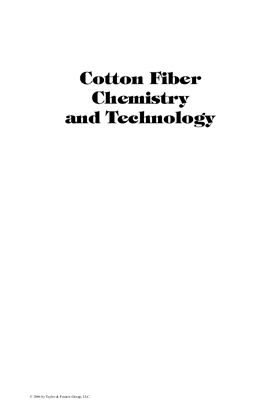Taylor&Francis, 2006. - 170 с.
Annual cotton production exceeds 25 million metric tons and accounts for more than 40 percent of the textile fiber consumed worldwide. A key textile fiber for over 5000 years, this complex carbohydrate is also one of the leading crops to benefit from genetic engineering. Cotton Fiber Chemistry and Technology offers a mode examination of cotton chemistry and physics, classification, production and applications.
This book incorporates new insight, technological developments and other considerations. The book focuses on providing the most up-to-date information on cotton fiber chemistry and properties.Written by leading authorities in cotton chemistry and science, this book details fiber biosynthesis, structure, chemical composition and reactions, physical properties and includes information on biotech, organic and colored cotton. The final chapters examine worldwide production, consumption, markets, and trends in the cotton industry.
They also address environmental, workplace, and consumer risks from exposure to processing chemicals and emissions. Tracing the conversion of cotton fibers from raw materials into marketable products, Cotton Fiber Chemistry and Technology offers a complete overview of the science, technology, and economic factors that impact cotton production and applications today.
В книге рассматривается современная химия и физика хлопка, классификация, производство и применение.
Annual cotton production exceeds 25 million metric tons and accounts for more than 40 percent of the textile fiber consumed worldwide. A key textile fiber for over 5000 years, this complex carbohydrate is also one of the leading crops to benefit from genetic engineering. Cotton Fiber Chemistry and Technology offers a mode examination of cotton chemistry and physics, classification, production and applications.
This book incorporates new insight, technological developments and other considerations. The book focuses on providing the most up-to-date information on cotton fiber chemistry and properties.Written by leading authorities in cotton chemistry and science, this book details fiber biosynthesis, structure, chemical composition and reactions, physical properties and includes information on biotech, organic and colored cotton. The final chapters examine worldwide production, consumption, markets, and trends in the cotton industry.
They also address environmental, workplace, and consumer risks from exposure to processing chemicals and emissions. Tracing the conversion of cotton fibers from raw materials into marketable products, Cotton Fiber Chemistry and Technology offers a complete overview of the science, technology, and economic factors that impact cotton production and applications today.
В книге рассматривается современная химия и физика хлопка, классификация, производство и применение.

